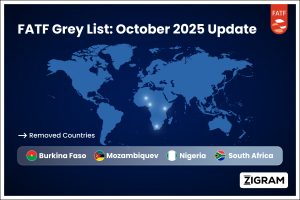Table of Contents
Key Takeaways: FATF Grey List 24 October 2025
Key Takeaways:
- Four African jurisdictions (Burkina Faso, Mozambique, Nigeria, South Africa) have successfully exited the FATF grey list as of 24 October 2025.
- No new jurisdiction was publicly added to the grey list in the 24 October plenary statement.
- The black list (high-risk jurisdictions subject to call for action) remains unchanged at this meeting.
- Removal from the grey list is a key milestone, but vigilance and compliance monitoring must continue for both countries and institutions.
What is the FATF Grey List?
FATF classifies jurisdictions with AML, CTF, or CPF weaknesses into two categories for monitoring and remedial action:
- “High-risk jurisdictions subject to a Call for Action” (often referred to as the “black list”) are jurisdictions with very serious deficiencies and risk to the international financial system.
- Jurisdictions under Increased Monitoring” (often referred to as the “grey list”) are jurisdictions that have significant strategic deficiencies but have committed to working with the FATF (or other international and regional body) to address them.
While less severe than blacklisting, grey listing brings heightened scrutiny, prompting banks to apply enhanced due diligence to such jurisdictions. On 24 October 2025, FATF released “Jurisdictions under Increased Monitoring,” listing countries removed, retained, or newly added to the grey list.
Changes effective 24 October 2025
Removals from the Grey List:
On 24 October 2025, FATF officially announced that the following jurisdictions have been removed from its increased monitoring (grey list):
Nigeria:
- Nigeria was placed on the FATF grey list in February 2023, largely because its mutual evaluation had revealed major weaknesses while the legal and regulatory frameworks, and effectiveness was very low (for example, very few complex money laundering investigations/prosecutions).
- FATF issued a 19-point action plan focusing on UN sanctions compliance, stronger beneficial ownership rules, better coordination, and more STRs.
- Over 2023‐2025 Nigeria delivered on these reforms:
- Enacted the Money Laundering (Prevention and Prohibition) Act 2022, the Terrorism (Prevention and Prohibition) Act 2022 and the Proceeds of Crimes (Recovery and Management) Act 2022.
- Launched a beneficial ownership register, improved NFIU capacity, improved coordination through a Sanctions Committee comprising 16 ministries/agencies.
- Submitted multiple progress reports to FATF, and by October 2025 it had reportedly addressed all 19 key action items that FATF had flagged.
- As a result, FATF judged Nigeria to have met the criteria for removal. The action plan was complete and the reforms were verified via on-site visit.
- The country still faces “residual challenges” (e.g., delays in some sanctions implementation, DNFBP training gaps), but these were no longer deemed strategic deficiencies.
South Africa:
- South Africa had been grey-listed in 2023 for 22 strategic deficiencies which included: weak investigation and prosecution of large/complex money laundering cases, inadequate oversight of certain non-financial sectors, weak targeted financial sanctions, and limited beneficial‐ownership transparency.
- The South African authorities undertook a multi-front reform:
- The central bank and Treasury ramped up efforts to enforce AML/CFT requirements and rebuild capacities damaged during the “state capture” era.
- There was a notable increase in money laundering convictions, e.g., one report noted 98 convictions between March 2023 – March 2024, which was a significant increase from previous years.
- Improved beneficial‐ownership transparency, improved supervision of non-bank financial sectors (including gatekeepers/private sector intermediaries).
- After conducting an on-site evaluation in 2025, the FATF determined that the country had completed the remaining action items and sufficiently aligned its frameworks with the FATF’s “40 Recommendations” and “Immediate Outcomes.”
- Hence, South Africa qualified for delisting. The delisting is hailed as a “watershed moment” for its financial sector.
Mozambique:
- Mozambique was listed on the grey list in 2022. Key deficiencies included weak institutional independence of the financial intelligence unit, inadequate risk-based supervision of banks and DNFBPs (designated non-financial businesses and professions), insufficient inter-agency coordination and resource constraints (financial/human) in AML/CFT front-line agencies.
- Since then Mozambique implemented reforms such as:
- Strengthening the operational independence and staffing of its Financial Intelligence Office (or the equivalent agency) so it could more effectively receive and analyse suspicious transaction reports.
- Introducing risk-based supervision for banks and DNFBPs (e.g., real estate, legal professionals, etc.) to align with FATF expectations of “gatekeepers”.
- Enhanced institutional collaboration across government agencies (law enforcement, FIU, supervisory authorities) to improve evidence gathering, prosecutions and asset confiscation.
- FATF concluded in its October 2025 plenary that Mozambique had satisfactorily addressed its strategic deficiencies and thus removed it from the grey list.
Burkina Faso:
- Burkina Faso had been subject to increased monitoring since 2021. Deficiencies included poor financial oversight, weak gatekeeper regulation, low ML/TF prosecution and asset recovery rates, and limited cross-border cooperation.
- Key reforms made by Burkina Faso:
- Strengthened oversight of both financial institutions and non-financial gatekeeper sectors, requiring better reporting of suspicious transactions and applying AML/CFT regulations across more sectors.
- Improved cross-border information sharing mechanisms, especially with regional bodies and in cooperation with the regional FATF-style body (e.g., GIABA) for West Africa.
- Improvement in asset-recovery laws and enforcement — i.e., more visible progress in confiscations, and stronger institutional frameworks for prosecuting ML/TF.
-
Consequently, FATF judged it had completed enough of its action-plan to warrant removal.
Additions Announced at this Plenary
Unlike some previous plenary meetings, on 24 October 2025 the FATF did not announce any new jurisdictions being added to the grey list (in the publicly-released “Increased Monitoring” statement). The focus at this meeting was on delistings.
Status of the Black List
At the same time, the FATF reaffirmed that the “High-Risk Jurisdictions subject to a Call for Action” list (the “black list”) remains unchanged in terms of new additions at this plenary.
Broader Context: Recent Additions and Removals in 2025
To understand the scale of movement in 2025, here are some of the relevant changes earlier in the year:
- February 2025:
- Added: Laos, Nepal
- Removed: Philippines
- June 2025:
- Added: Bolivia, Virgin Islands (UK) (British Virgin Islands)
- Removed: Croatia, Mali, Tanzania
Implications and Key Messages for Stakeholders
For jurisdictions removed:
- Delisting signals FATF and peer satisfaction, showing the country has addressed deficiencies and fulfilled its action plan commitments.
- For financial institutions, it reduces the stigma and risk premium associated with transacting with that jurisdiction; correspondent-banking relationships, cross-border capital flows and trade‐finance operations may face fewer restrictions. For example, the IMF has found that being on the grey list can reduce foreign capital inflows by an estimated ~7.6% of GDP in some cases.
- However, removal isn’t “mission complete” — the jurisdiction remains under regular monitoring and must uphold global AML/CFT standards. One statement noted: “exit does not shield from scrutiny”.
For jurisdictions still on the grey list:
- Continued listing means heightened oversight: financial institutions should apply enhanced due diligence when dealing with entities in those jurisdictions.
- The jurisdiction must still implement its action plan within the agreed timeframe; failure may lead to transition to the “call for action” (black list) if deficiencies are too serious or unaddressed.
- From a business/compliance perspective: risks remain higher for correspondent banking, trade finance, and the jurisdiction may suffer reputational impact.
Final Thoughts
Grey list movements reflect nations’ efforts to strengthen AML/CFT/CPF through reforms, stronger institutions, oversight, and global cooperation. For your company’s domain, the significance is two-fold:
- Jurisdictional risk management: The status of a country on the FATF grey list should be a parameter in your risk-rating/monitoring engine.
- Market positioning: Delisted jurisdictions may attract more cross-border investments and banking access, boosting AML/CFT compliance demand and economic growth. Conversely, firms operating in jurisdictions still under monitoring may face higher compliance burdens and strategic risk.
To stay ahead of such issues, use our AI/ML-powered products to receive real-time updates, onboard faster, and ensure 100% AML compliance.
- #GENIUSAct
- #Stablecoins
- #AML
- #FinancialCrime
- #Compliance
- #CryptoRegulation
- #FinCEN
- #SanctionsCompliance
- #RegTech
- #AntiMoneyLaundering
- #DigitalAssets
- #FinancialSecurity








